11/1/2018
Czech List
Chris Beytes
What does the garden center industry look like in a country that was ruled by communists just 30 years ago? To find out,
Green Profit joined 175 garden center owners, managers and suppliers from 16 countries on the International Garden Center Association’s tour of the Czech Republic, September 16-21*. There, we found a young “zahradniché centrum” industry embracing the best of Europe’s trends—and even beginning to find their own voice in garden center design and display. Here are some highlights:
Where’s the Czech Republic?
Landlocked in central Europe, Czechia (the country’s official nickname) is surrounded by Poland to the northeast, Germany to the northwest and west, Austria to the south and Slovakia to the east. Prague, the tour’s home base, is the capital. Outside of the city, the country is mostly agricultural, with lots of barley and wheat production with which they feed their need for beer—Czechia reportedly has the highest beer consumption in the world.
2018 is the 100th anniversary of Czech independence after centuries of rule by the Austrian Habsburgs. The country of Czechoslovakia was formed in 1918, but after WWII, when the Russians helped free Czechoslovakia from the Germans, the country was occupied by the communist Soviets until the fall of the Berlin Wall in 1989.
Czechoslovakia split into Czechia and Slovakia in 1993, which means it’s a young capitalist market, with all the garden centers we’ve visited being less than 30 years old. I’m told it’s the most stable and prosperous of the former Soviet countries. There aren’t many signs of the communist days left, as the country has worked rapidly to Westernize. The most obvious signs are the rows of plain apartment buildings that dot the cities. They’ve been painted in pretty colors and patterns in an effort to brighten them up.
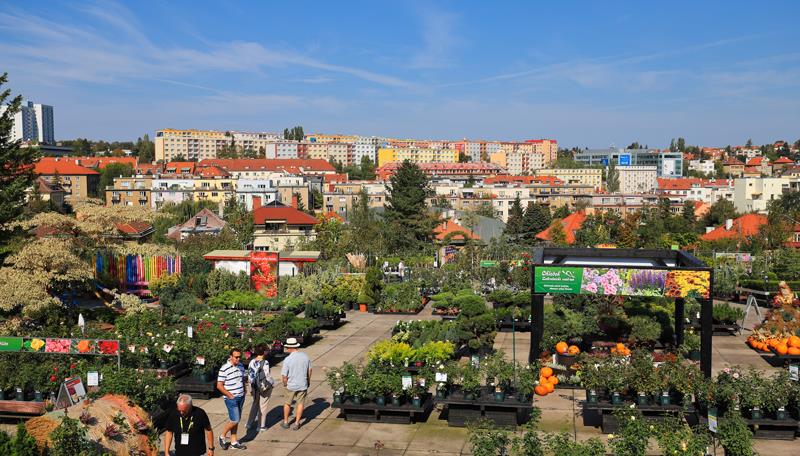 Pictured: The most obvious remnants of the communist days are the rows of plain apartment buildings that dot the cities. They’ve at least been painted.
Pictured: The most obvious remnants of the communist days are the rows of plain apartment buildings that dot the cities. They’ve at least been painted.
But Prague itself? Beautiful! The old buildings were not damaged in WWII like in so many other capitals, so the city is a textbook of architecture through the centuries.
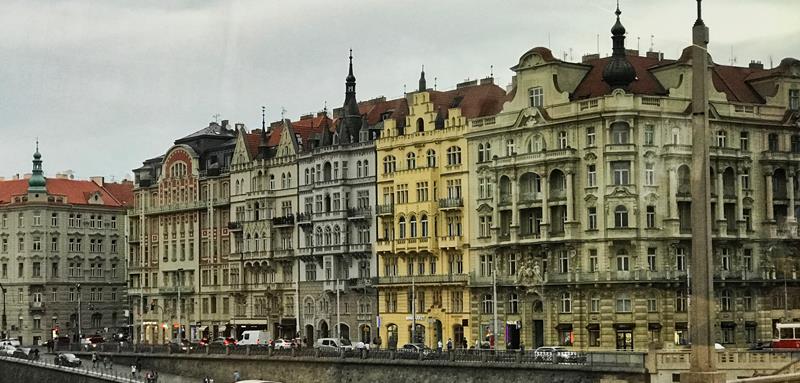 Pictured: Prague is considered one of the best-preserved cities in Europe, and a textbook of architectural styles. Garden centers, however, lean toward the sleek and modern.
Pictured: Prague is considered one of the best-preserved cities in Europe, and a textbook of architectural styles. Garden centers, however, lean toward the sleek and modern.
Under communism, all land and businesses were taken over by the state, and even if a nursery operated under state ownership, it grew only basic trees and shrubs. One could buy plants, but there were no garden centers per se. It sounds like a dreary time: For instance, a butcher told us that the Soviets made all restaurants serve the same food cooked to the same recipes. So few people ate out. That certainly has changed now, as the Prague restaurant scene is burgeoning, with two Michelin-star eateries. A favorite theme is to put a modern twist on grandma’s classics.
Because of that, another remnant of the communist days is the Czech penchant for growing their own food. We were told that during the soviet occupation, even if you lived in an apartment you were given a small plot of land on which to grow produce and the habit persists. When we peeked over garden walls we saw fruit trees, vegetable patches and small greenhouses. Some flowers, yes, notably window boxes spilling forth ivy geraniums, but not extensive displays of color.
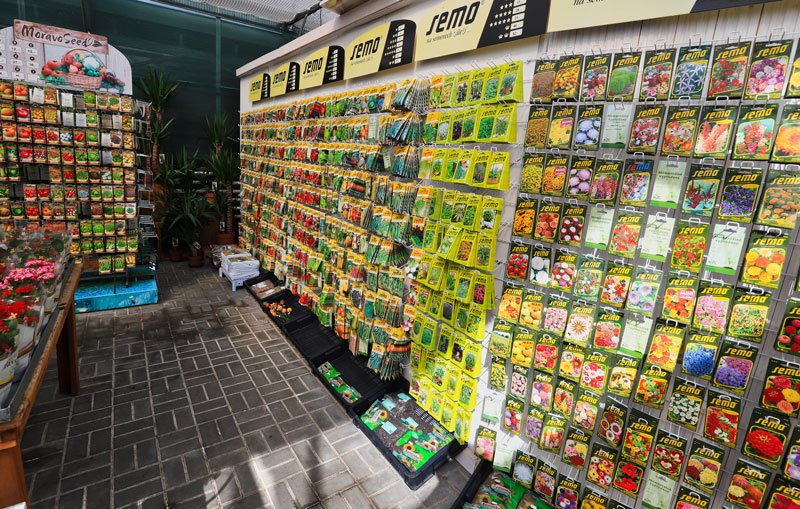 Pictured: Lots of seeds and lots of fruit, vegetable and herb offerings indicate the Czech people like to grow their own food—a positive vestige of the communist days.
Pictured: Lots of seeds and lots of fruit, vegetable and herb offerings indicate the Czech people like to grow their own food—a positive vestige of the communist days.
In the garden centers, seeds, herbs, veggies, and fruit bushes and trees are ubiquitous. But we also saw plenty of seasonal annuals and blooming houseplants, so obviously those do get purchased.
We asked about the foliage and succulent trend. Customers are interested, but they haven’t taken off like in the rest of the West. That’s in part due to lower incomes and less disposable incomes. However, the category is growing and there’s plenty available in the garden centers, mostly from the German and Dutch auctions.
A Young Industry
Most of the garden centers we visited were founded in the mid-’90s or later, even if the original nursery business goes back several generations. Given that, they’ve come a long way, thanks to driven, enthusiastic owners who’ve traveled Europe and worked with the best consultants to bring back the best ideas.
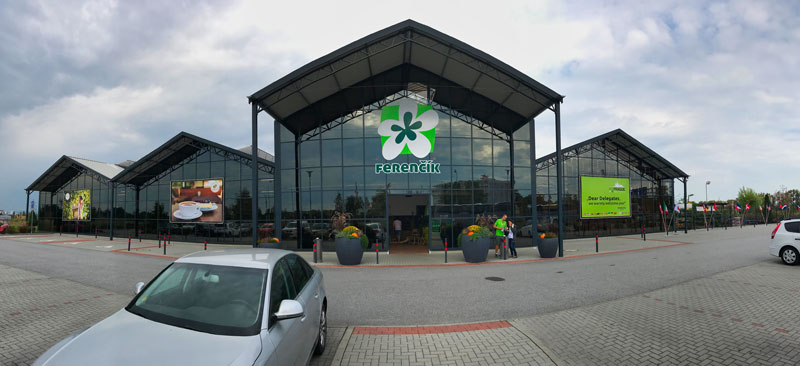 Pictured: With its modern frame, tinted glass and seasonal signage, second-generation Ferenčík Garden Center was obviously inspired by the best of the Western European IGCs.
Pictured: With its modern frame, tinted glass and seasonal signage, second-generation Ferenčík Garden Center was obviously inspired by the best of the Western European IGCs.
The result is that Czech garden centers don’t necessarily look “Czech” (whatever that might mean). Architecturally, new greenhouses have designed in a Dutch or German style, with painted frames, tinted glass at the front, and large, colorful banners depicting seasonal scenes. Inside, benches and displays leaned toward the modern, western European style. A good example is Ferenčík Garden Center, the largest garden center in the southern part of the country, with 20,000 sq. ft. of retail greenhouse and 100,000 sq. ft. of total space. They do almost $2 million in sales.
Two features Czech garden centers have added most recently are cafés and gourmet food departments. I was told by one consultant that we wouldn’t have seen either two years ago. Now, most of the places we visited had coffee shops and decent gourmet food offerings. Chládek garden center does more than $1 million in annual restaurant business.
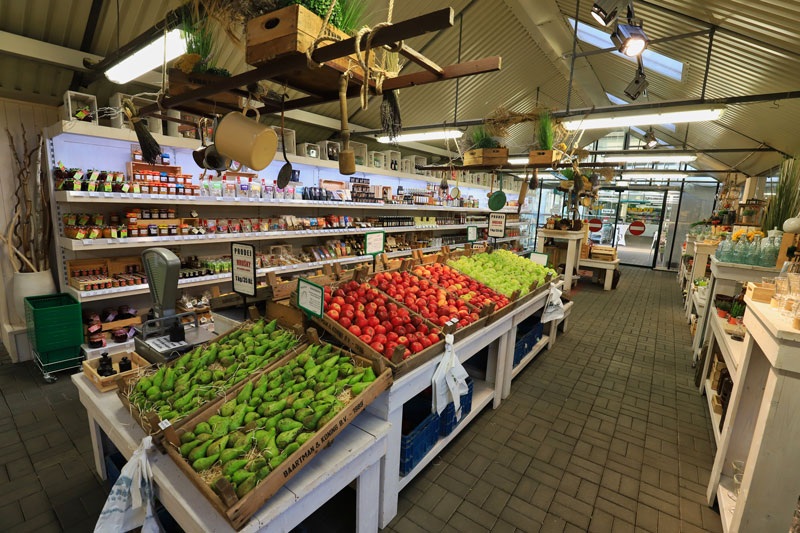 Pictured: The fresh and gourmet food department at Dvorak and Sons—a relatively new addition to Czech garden centers.
Pictured: The fresh and gourmet food department at Dvorak and Sons—a relatively new addition to Czech garden centers.
Is There a True “Czech” IGC?
Speaking of Chládek, I asked if we’d see a “Czech” garden center—one that showed some authentic local flare—and was told this was it! A big, modern, two-bay greenhouse and nursery on the side of a hill overlooking Prague, Chládek Zahradniché Centrum was founded in 1992 by a family with more than 100 years in horticulture.
 Pictured: Chládek is the Czech Republic’s largest garden center, with more than $5 million in sales. It’s also perhaps the most “Czech” of them all, thanks to a combination of rustic and modern displays. I also noted that floors were stained concrete instead of the more typical concrete pavers. Outside, comfortable seating encourages guests to relax and stay for a while.
Pictured: Chládek is the Czech Republic’s largest garden center, with more than $5 million in sales. It’s also perhaps the most “Czech” of them all, thanks to a combination of rustic and modern displays. I also noted that floors were stained concrete instead of the more typical concrete pavers. Outside, comfortable seating encourages guests to relax and stay for a while.
I noted two things at Chládek that might be considered “Czech.” First, a combination of modern and rustic displays. For instance, down the center of the entrance bay was a giant table made from massive timbers (railroad ties) and some wrought-iron garden tables and benches. In contrast, the outside of the bay was lined with sleek Euro-style aluminum tables wrapped with bench tape.
In the gift area, I noted they switched between display furnishings depending upon the product category: Home décor was on modern, whitewashed wood displays, while across the aisle, gourmet food was on ornate French-style furnishings.
Second, outdoor seating. Most garden centers have the random bench upon which weary customers can take a load off. At Chládek, they have four, room-size seating areas out in their landscape department. Perhaps they serve as an extension of their restaurant, which is nearby—two did feature beer garden-style tables and chairs. But I’ve never seen deep seating for six and a coffee table in a garden center. And they had two such spots. A great way to get your customers to relax and stay longer.
Oh, animals, too! Quite a few of the centers, including Chládek, had rabbits, Guinea pigs or goats to entertain the kiddos. That also seems to be a Czech thing.
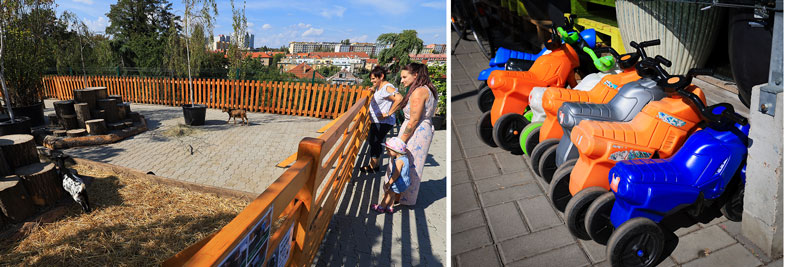
Pictured: How do Czech IGCs keep moms shopping? By keeping the kiddos entertained with animals. One center offered these plastic ride-ons.
They Know Our Brands
You’d feel comfortable in a Czech garden center, thanks to Yankee Candle (which recently opened only its second factory here, to better serve Europe); Weber, Fiskars and Gardena. They like vintage tin advertising signage with American icons such as John Deere, Coke, Harley-Davidson and Route 66. And the plant selection is typical European, with much of the supply coming from Dutch and German growers.
Thank goodness we spotted a display of “zelaks”—ceramic crocks for making sauerkraut. It was probably the most “Czech” of all the products we saw.
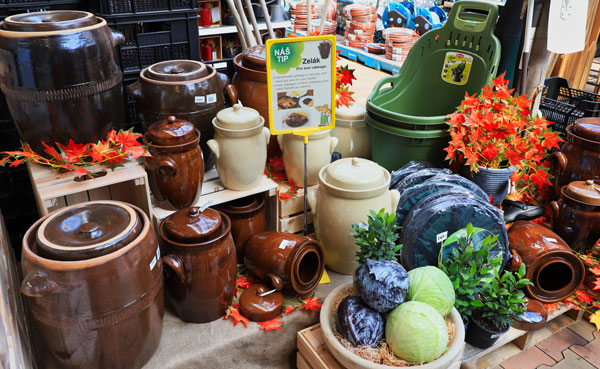 Pictured: Perhaps the most “Czech” display we saw—nicely cross-merchandised with cabbage, sweet bay and wheeled totes.
Pictured: Perhaps the most “Czech” display we saw—nicely cross-merchandised with cabbage, sweet bay and wheeled totes.
* The IGCA is the association of the world’s garden center associations. There are currently 18 member countries; AmericanHort is the U.S. member. Since 1960, IGCA has held an annual “Congress” somewhere in the world to tour garden centers and share ideas and best practices.
Next Year
In 2019, the International Garden Center Association will be touring garden centers around Windsor, England, September 1-6. You’ll see the best of England’s retailers, plus Kew and Wisley Gardens and much, much more. Learn more at igca2019.co.uk. GP